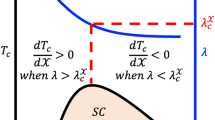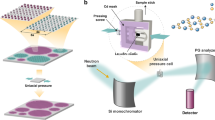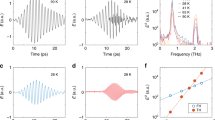Abstract
Arising from: J. Hwang, T. Timusk & G. D. Gu Nature 427, 714–717 (2004); Hwang et al. reply In conventional superconductivity, sharp phonon modes (oscillations in the crystal lattice) are exchanged between electrons within a Cooper pair, enabling superconductivity. A critical question in the study of copper oxides with high critical transition temperature (Tc) is whether such sharp modes (which may be more general, including, for example, magnetic oscillations) also play a critical role in the pairing and hence the superconductivity. Hwang et al. report evidence that sharp modes (either phononic or magnetic in origin) are not important for superconductivity in these materials1, but we show here that their conclusions are undermined by the insensitivity of their experiment to a crucial physical effect2,3,4,5,6,7.
Similar content being viewed by others
Main
The optics experiment performed by Hwang et al. measures a momentum average and is therefore not a sensitive probe when the signal is strongly momentum dependent, as it is for these materials. Existing angle-resolved photoemission (ARPES) data show that in the strongly overdoped regime (with Tc = 58 K) there is a prominent ‘kink’ that is indicative of a peak in the self-energy2 (Fig. 1). Figure 1b reveals a clear dispersion kink in the superconducting state near 40 meV (arrow). The strong presence of the mode signal in this comparably overdoped sample is in contradiction of the central claim of Hwang et al.1.
a, Normal-state data (T = 85 K) from an overdoped sample near the antinodal region (c). b, Superconducting-state data from the same sample at 10 K, showing the emergence of a dispersion kink in the bilayer split-B band (arrow). c, d, Momentum dependence of the strength of the temperature-dependent kink (the real part of the self-energy Σ, taking the normal-state curve as reference) from an overdoped Tc = 71 K sample (d), with locations indicated on the Brillouin zone (c). The normal (red) and superconducting (blue) dispersion curves for the extreme locations are shown as well. The ARPES spectra discussed in ref. 1 were taken at 45° (the node, for example). Reprinted with permission from ref. 2; copyright (2003) of the American Physical Society.
Figure 1c, d shows that the kink strength (or the peak height of the extracted self-energy, ReΣ) from an overdoped sample with Tc of about 71 K is hardly detectable near the node, but is quite strong near the antinode. Hwang et al. make no mention of the clear, positive ARPES signal at the antinode, which would otherwise have ruled out their conclusion1.
References
Hwang, J., Timusk, T. & Gu, G. D. Nature 427, 714–717 (2004).
Gromko, A. D. et al. Phys. Rev. B 68, 174520 (2003).
Kaminski, A. et al. Phys. Rev. Lett. 86, 1070–1073 (2001).
Sato, T. et al. Phys. Rev. Lett. 91, 157003 (2003).
Abanov, A., Chubukov, A. V., Eschrig, M., Norman, M. R. & Schmalian, J. Phys. Rev. Lett. 89, 177002 (2002).
Cuk, T. et al. Phys. Rev. Lett. 93, 117003 (2004).
Devereaux, T. P., Cuk, T., Shen, Z.-X. & Nagaosa, N. Phys. Rev. Lett. 93, 117004 (2004).
Author information
Authors and Affiliations
Corresponding author
Rights and permissions
About this article
Cite this article
Cuk, T., Shen, ZX., Gromko, A. et al. Sharp-mode coupling in high-Tc superconductors. Nature 432, 1 (2004). https://doi.org/10.1038/nature03163
Published:
Issue Date:
DOI: https://doi.org/10.1038/nature03163
This article is cited by
-
Sharp-mode coupling in high-Tc superconductors (reply)
Nature (2004)
Comments
By submitting a comment you agree to abide by our Terms and Community Guidelines. If you find something abusive or that does not comply with our terms or guidelines please flag it as inappropriate.




